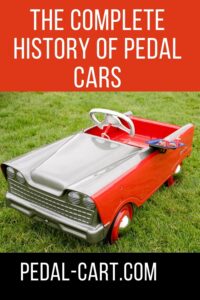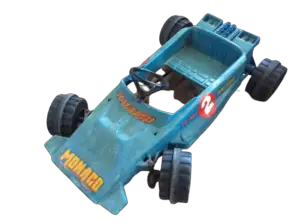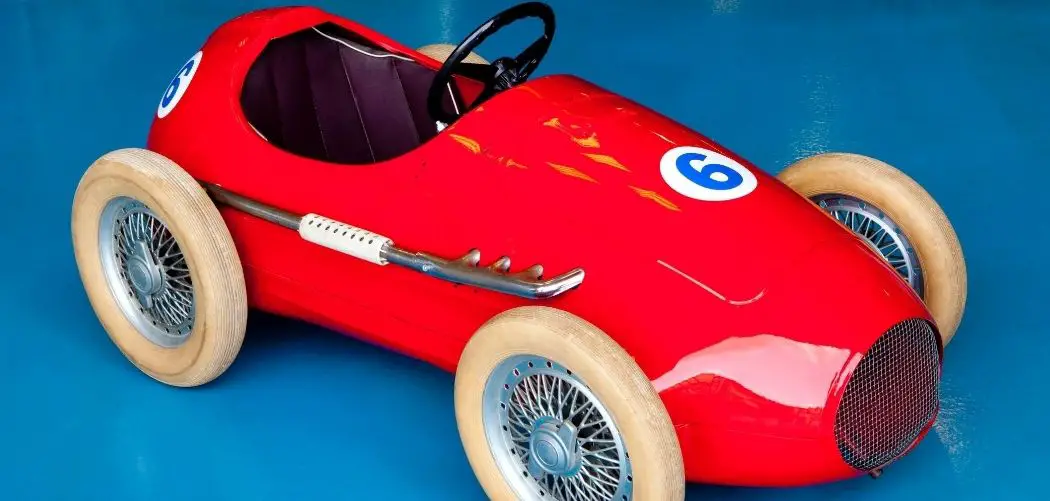
Many automobile enthusiasts have been lusting after pedal cars ever since they were kids — and for good reason too! They are not only beautiful but also incredibly fun for children of all ages. Even as adulthood approaches, you have likely thought long and hard about purchasing one (whether you have young children or not).
But, do you truly know the full history of pedal cars? How did they come into being? What sparked their manufacture? Why are they so widely admired today?
You are about to find out all of that and more. Excited? We know we are, so let’s not waste any more time and get started!
Table of Contents
The Complete History of Pedal Cars
We’ll begin where everything started…
The 1890s
The first pedal car was built in the 1890s, soon after the regular car made its debut appearance. Of course, they were modeled off the real cars that were seen driving along the road at this time — they had nothing else to work from after all.
As soon as they hit the market, children around the United States of America wanted one. It’s safe to say that Santa’s mailbox was filled to the brim with pedal car requests that year!
Unfortunately, they were pretty pricey (as were the road cars at the time) so unless you came from a wealthy family, actually getting one of these bad boys was not an option. Not to mention that you would’ve needed to live by a railway — transporting hunks of steel in the post just wasn’t possible.
But everyone still admired them from afar. In fact, some working-class families attempted to make their own wooden versions at home.
The 1920s and 1930s

Then, the 1920s and 1930s rolled around. Still, pedal cars were made solely for the wealthy so the companies catered for upper-class children only. Who could blame them? That was where the money was!
Large manufacturers started making more pedal cars and go-karts around this time too (again, still marketing the wealthy). If you are a die-hard fan, you might recognize some of the companies that jumped on the bandwagon in the early nineties:
- Sears
- American National Automobiles of Toledo — they made famous pedal car models such as the Skippy Airflow Chrysler, Ford, Chevrolet, and Pontiac
- Steelcraft of Murray — these guys made GMC pedal trucks, Model T Roadsters, Dodge Runabouts, Chrysler Roadsters, dump trucks, and more
- Keystone
- Buddy L
As road car manufacturers began to “modernize” their vehicles, so did the pedal car makers. Why? So they could stay up to date and keep the kids interested in their products of course!
World War II (the Mid 1940s)
World War II started in the middle of the 1940s, which saw the demise of pedal cars. No one, not even the big industry players, was making them.
But to be honest, everyone had much bigger things on their minds.
Since many men went off to fight, the materials used to produce pedal cars (and other toys for that matter) were utilized as war resources. Thus, no more games for the little ones.
The 1950s and 1960s
While pedal cars and working-class go-karts reached their peak in the 20s and 30s, there was a spike in development after the war. All toy stores — the large ones, at least — were selling them and again, every post-war child wanted one to show off to their friends.
Automobiles had really picked up their game, so just like before, pedal cars also started to become more “high-tech”. They came in a huge array of colors, makes, and models. They were mimicking the fancy road cars. The kids went mad for them.
By the middle of the 1960s, these children’s toys had working lights, chrome details, hood ornaments, custom paintwork, adjustable windshields, moveable ragtops, white tires, and beeping horns. Back then, people got their first set of wheels at a very early age!
They did not stop there.
As times changed, the industry leaders realized that people couldn’t get enough of this invention. So, what do you think happened?
Yep, they diversified!
Not only did they produce an increasingly large number of pedal cars but they also started manufacturing pedal planes. The main ones were the Shark Attack, Fantasy Flyer, and the Red Baron. Each model featured high-quality tires, non-slip pedals, movable propellers, classic paint jobs, and a full metal chassis. Definitely something worth bragging about!
The 1960s was the era that saw amazement with space and air travel. Plus, plastics and toy safety standards came into the mix, which (as you’ve probably guessed), changed the pedal car game for good.
Suddenly, every vehicle you could imagine was made as a kids’ pedal model. Companies were throwing out pedal trucks, pedal tricycles, and pedal trains. Everything you could dream of and more!
The 1970s
 It wasn’t until the 1970s that the plastic pedal car came into being. Just like the industry leaders expected, this blew up and became far more popular than the steel version.
It wasn’t until the 1970s that the plastic pedal car came into being. Just like the industry leaders expected, this blew up and became far more popular than the steel version.
Sadly, this made the production of the original steel pedal cars go extinct.
The newer, safer plastic designs were mass-produced and available to everyone — wealthy, poor, working-class, or other. While this was great, they did not look like the adult automobiles anymore.
Essentially, they were just hunks of plastic, and there came the end of the pedal car era.
Today’s Times (The 2000s)
Today, we operate with a “throw-away” mentality. In other words, trends arrive and leave incredibly quickly and when things break, we don’t try and fix it.
However, many people still find endless amounts of joy in owning a pedal car. If you are here with us, you are likely one of those people! Universities around the world have now started to study the structure for suitable frames for pedal cars, you know that it’s an important subject.
Yes, it is a very niche collector’s item nowadays, but that makes it even more worthwhile. Finding an original is also really unlikely but if you have one in your clutches, never, ever let it go. You’ll be sorry that you did.
The workmanship, the care, and the beauty of pedal cars have stood the test of time. While they are hardly ever bought as children’s toys now, they are treasured collectibles in the hands of vintage lovers.
You just can’t always find this sort of quality in manufactured toys today. So, people turn to the original pedal car to bring them Marie Kondo style joy.
After all, what sparks joy should always stay.
The Most Popular Models
For those of you who can’t get enough of talking about pedal cars, don’t worry, we have got more for you.
How else could we finish the complete history of pedal cars without talking about the most popular models of their time? Exactly, we couldn’t!
The Gendron Packard Pedal Car
Much like all of their pedal cars back in the day, this one was made in the 1930s in their classic red and burgundy color scheme. Honestly, you have to see it to believe its beauty.
The 1941 Alfa Romeo Alfetta
You can find replicas of this one but the original will cost you over $2,000.00 and it’s unlikely that it’s for sale.
It features that classic red design, chrome spokes, and a moveable wheel.
The 1930 Sad Faced Fire Engine
Someone out there owns this and let’s just say they are one lucky duck! Of course, you can see that iconic “sad face” on the front, the classic hood ornament, thin wheels, bright red bodywork, and the chrome details.
Unfortunately, a picture is the best we can do for you here!
The 1948 Comet Pedal Car
The original was made in 1948 but companies have been making replicas for years. This one has the chrome hood, grill ornaments, headlights, steering wheel, hubcaps, and windshield.
Since it isn’t the original, you can guarantee the safety of the build so it’s perfect for a children’s toy. (Sorry to all the collectors here with us).
The 1922 Model T Ford Pedal Car
This one had that eye-catching silver and red paintwork that people of that era loved (especially the kids). With thin wheels, a huge grill, chrome-detailed windshield, and a varnished steering wheel, it certainly screamed “class” across the playground.
The 1965 Ford Mustang Pedal Car
The 1965 Ford Mustang is arguably the most popular model to this day. Usually, we’ve found that those who prefer the Model T think nothing of the Mustang. You could say divided people.
The 1939 Mercury Woody Wagon Pedal Car
Okay, this is not necessarily one of the most popular models out there (sorry) but we couldn’t resist including this. Why? It is nothing but authentic. Once you have had a look at it, you’ll get what we mean.
The 1963 Chevrolet Corvette Stingray Pedal Car
This model was insanely popular back in the day. Seemingly, most of the population loved red pedal cars back then and it must have stuck. The Chevrolet Corvette Stingray is stunning with its white accents, bonnet shape, and white tires.
Honestly, we could go on for hours but we should probably leave you in peace!

